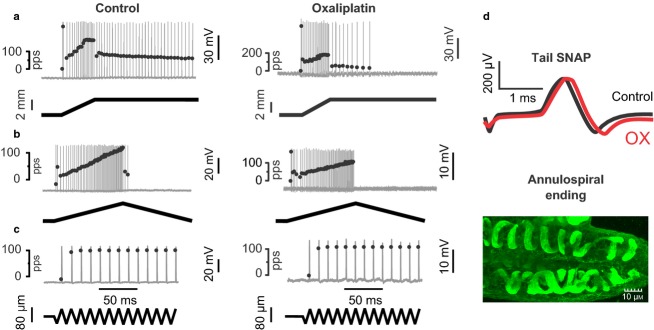Fig 3.

Chronic oxaliplatin (OX) treatment abbreviates static phase firing without neuropathy. Electromechanical data arranged vertically for one IA afferent sampled in vivo from a control rat and for one IA afferent taken from a rat 5 weeks after injections of OX (1/week for 4 weeks; cumulative dose 70 mg/kg). Firing of the IA afferents (top traces) is shown in response to three different forms of muscle stretch (bottom traces): (a) ramp-hold; (b) triangular; (c) vibration. Action potentials are shown as vertical lines firing at instantaneous firing rates indicated by superimposed black dots. During the static (hold) phase of muscle stretch (a), IA afferents in normal rats typically sustained firing, but those in OX-treated rats rapidly adapted and ceased firing. By contrast, during dynamic (changing length) phases of muscle stretch (a–c), IA afferents were similarly responsive in control and OX-treated rats. Also, IA afferents in both groups displayed high-frequency initial burst firing at the onset of ramp (a) and triangular (b) stretches, and fired with 1 : 1 entrainment to muscle vibration at high frequency (100 Hz) and low amplitude (0.08 mm) (c). (d) Data demonstrate the absence of neuropathy: top traces show that electrically evoked sensory nerve action potentials (SNAPs) recorded from the tail before and after treatment in the OX rat were indistinguishable; the bottom image represents finding that muscle spindles in OX rats were consistently innervated by normal-looking annulospiral endings (stained with PGP9.5).
